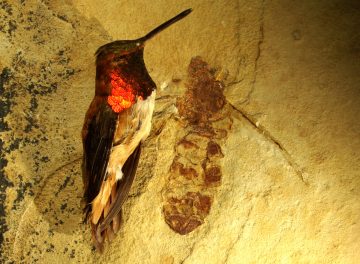Giant ants crossing the Arctic: why do plants and animals live where they do?

The giant ant “Titanomyrma” crossed the ancient Arctic to appear in both Europe and North America about fifty million years ago.
How did the strange climate of fifty million years ago and the movement of continents affect modern patterns of plant and animal distribution? How did palm trees thrive on the shore of the Arctic Ocean and insects that are today native to the tropics inhabit the temperate uplands of British Columbia? Why were the forests of British Columbia and Washington home to life native to East Asia today? And what does the discovery of the giant ant Titanomyrma near Princeton, BC tell us about how different kinds of plants and animals crossed the Arctic to appear in both Europe and North America? Curator of the Beaty fossil collection paleontologist Dr. Bruce Archibald talks about the big picture distribution of plants and animals across latitudes and continents in the second of his Beaty lecture series on life in the ancient forests of British Columbia and Washington and what they tell us about how patterns of life in the modern world came to be.
Program Schedule:
-
- 5:00 pm: Doors open with ADMISSION BY DONATION
- 6:00 pm – 7:00 pm: Presentation and Q&A session
- 7:00 pm – 7:30 pm: Half-Hour Highlight – Museum Tour
- 8:30 pm: Museum closed
About the Speaker
 Paleontologist Dr. Bruce Archibald is the Curator of the Fossil Collection at the Beaty Biodiversity Museum, and he holds a Ph.D. in Evolutionary Biology from Harvard University. Dr. Archibald has worked on fossil insects for about two decades and has published 63 papers in scientific journals. He particularly enjoys speaking to school and community groups to spread scientific knowledge.
Paleontologist Dr. Bruce Archibald is the Curator of the Fossil Collection at the Beaty Biodiversity Museum, and he holds a Ph.D. in Evolutionary Biology from Harvard University. Dr. Archibald has worked on fossil insects for about two decades and has published 63 papers in scientific journals. He particularly enjoys speaking to school and community groups to spread scientific knowledge.
